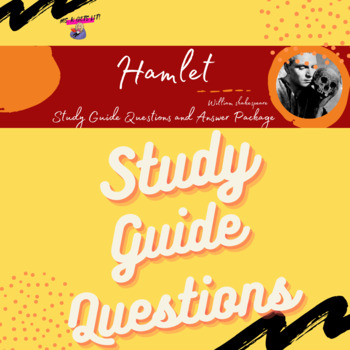Hamlet Study Guide Questions and Answer Key
- Zip
Description
This is a Hamlet by William Shakespeare study guide question and answer package. This question study guide can be used in high school level academic or university level courses, most appropriate for Grade 11 or 12 University. The package can be provided to students on the first day of the unit and they answer the questions as the play is being studied. These are not only knowledge based but are also higher-level analytical questions. The analysis of literary devices and elements are included in almost all of the questions and answers (thinking and application). In addition, the focus is on examining the novel using literary theory. The theories applied are archetypal, psychoanalytical, feminist, and Marxist. The questions/answers related to the study of literary devices and elements are highlighted yellow, while the questions and answers related to the application of any of the four literary theories are highlighted in blue. This strategy works well for organization purposes but it also helps students understand the expectations in the questions.
Direct proofs are used from the play within answers to support certain points/analysis. Essentially, a study guide like this prepares students for essay writing as they practice applying direct proofs to support their answers.
The answer key has certain lines/words/ideas highlighted if you plan on projecting the answers for your students or posting the answers to your online class. The highlighted parts are normally what I would like students to copy down. The teacher answer key document contains 24 pages and the student copy is another 14 pages; text boxes have been included under each question for students to type their answers into.
You can easily convert the documents from Microsoft Word to a Google Doc by opening Google Docs, clicking on "File", then "Open", and then "Upload". The Word document will convert perfectly and look exactly the same as the Word version. Once you do that, if using Google Classroom, you could "make a copy" for each student of the student copy and students will be able to work on the questions individually within their own Google Doc and then submit it to you.
You'll love this product as the analyses of the entire play is included within the answer key and it will just require you to review the answers. You won't be disappointed. I promise.
Do you need resources to teach literary theory? I got you! I have Google Slides presentations, student notes, and lessons prepared for you.
You might find these helpful ...
Archetypal Literary Theory and Carl Jung Google Slides Presentation
Freud's Psychoanalysis Theory / Lens Lesson and PowerPoint Presentation
Feminist Literary Theory Google Slides Presentation
Marxist Theory / Lens PowerPoint Presentation
Postcolonial Literary Theory Google Slides Presentation
Happy teaching!
Please don't hesitate to reach out if you have any questions.
Happy teaching!
Copyright @MsKGetsLit
Permission to copy for single classroom use only. If you intend to share this product, please purchase additional licenses.





